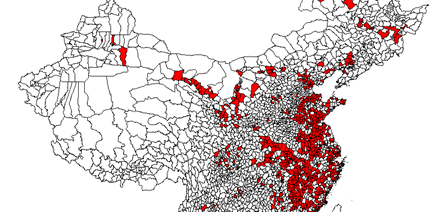
China’s special economic zones found to reap billions of dollars in net benefits
Study of a mid-2000s wave of new special economic zones in China finds net economic benefits of over US$15 billion thanks to capital investment, employment, business entries, and other factors
Governments use special economic zones (SEZs) to incentivize firms to enter a region and form industrial clusters. This collective force, called an agglomeration economy, brings benefits such as greater productivity and wages, technological advances, and price impacts. SEZs have been around since the mid-20th century and are a popular strategy worldwide, but there have been few studies of their true success or failure, or looking at them over time.
In China, SEZs have been prominent in economic policy since 1979, which makes Chinese SEZs an ideal subject of study. A trio of Chinese researchers centered at Osaka University set out to intensively analyze the effects of these SEZs. Using data on over three million firms, they conducted a study focusing on a Chinese initiative to add hundreds of development zones between 2005 and 2008. They reported their findings in American Economic Journal: Economic Policy .
The researchers examined the local effects of SEZs on targeted areas, the SEZs’ overall costs and benefits, and how zones’ specific features affected outcomes. Key among the findings was that the SEZ initiative yielded around US$15.26 billion in net benefit over three years. The greatest positive effects were on capital investment, employment, output, productivity, and wages.
“We built a novel dataset that combined geocoded economic census data with comprehensive data on these SEZs,” says study senior author Lianming Zhu. “We could see firms’ ages, sectors, addresses, investment, employment, and output. We saw evidence of agglomeration economies and we also found factors behind them.”
Net entry of firms seemed to play a major role in the positive outcomes. Existing firms in the regions benefitted less. The researchers also found that firms in capital-intensive industries benefitted from SEZs more than firms in labor-intensive industries, likely owing to the zones’ various subsidies for capital investment.
They additionally noted that China’s SEZ policies underscore the importance of considering firms’ particular circumstances. In China, SEZs offered a level playing field with better regulations and infrastructure, while maintaining advantages for large-sized companies. This heterodox approach may differ from Western approaches.
“Among economists, there’s skepticism about SEZs,” Zhu says. “Our study should help dispel that. This is the first strong evidence about SEZs’ local economic effects and their benefits and costs. We also found factors that make them effective. Considering developing countries are seeking to attract domestic and foreign investment with SEZs, these are valuable findings that can be of global use.”

Figure: Chinese counties where special economic zones were newly established are indicated by the shaded areas
The article, “Place-based policies, creation, and agglomeration economies: Evidence from China's economic zone program” was published in American Economic Journal: Economic Policy at DOI: https://doi.org/10.1257/pol.20160272.
Related links
